Daniele
Posts: 1812
Joined: 2/7/2015
Status: offline

|
Chapter 1 Conquest of France
Introduction to the After Action Report (AAR)
This AAR is of a NetPlay game of Global War played by G (Allies) and S (myself - Axis). We used many of the optional rules, such as: divisions, carrier planes, offensive chits, oil, limited overseas supply, amphibious units, combat and construction engineers, variable reorganization costs, the 2D10 land combat CRT, and [important for G’s naval strategy] In The Presence Of The Enemy. Once we had agreed on the optional rules, I started the game and G joined in by simply logging into the Private WIF NetPlay Forum. A couple of mouse clicks later we were underway.
For communicating with each other during game play, we used Skype. It is a free download and worked very well for us. NetPlay as implemented in Matrix Games World in Flames (MWIF) handles all the communications between the two computers, each of which runs its own copy of the program and maintains it own internal copy of the “game state”.
When one player moves a unit, NetPlay sends a message to a Matrix Games NetPlay server, which forwards it to the other player’s computer. The other player’s computer then updates its copy of the game state. This keeps the computers in synch as to what is happening in the game. Because MWIF uses the NetPlay server, neither players’ computer needs to act as a ‘master’ or ‘slave’.
There are some phases of the game where the players make decisions simultaneously. For example, that happens during the Production phases and when deciding whether air units fly as fighters or bombers. The way NetPlay handles those phases is that it collects all the decisions, and once both players have finished the phase or subphase, NetPlay sends the decisions en masse to the other computer. Play then resumes as usual.
First Attack into France
I have chosen to start this AAR with the conquest of France. In the game, as in the actual war, this was a major turning point. This post ends with Germany having occupied Paris. As Germany decided historically, I chose to declare Vichy France after having taken Paris. The second chapter of this AAR describes the war prior to the Germans attacking into France proper.
But we start with the screenshot from Mar/Apr 1940, Impulse #10 (Figure 1-1) with the Axis to decide whether to declare war on any other countries. Germany is at war with both France and the Commonwealth, while Italy is still neutral. This is late in the 4th turn of the game and the first time in 1940 that the weather has been Fine in the North Temperate weather zone.
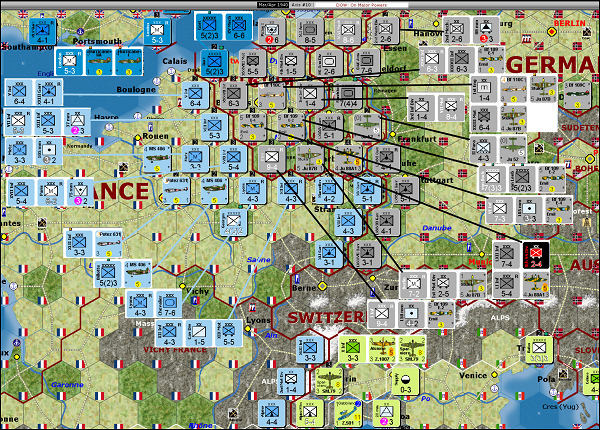
G used the fine weather in the previous impulse (#9) to have the Commonwealth attack along the coast, destroying a German 5-3 Militia and advancing into a hex of Belgium. Shore bombardment from the North Sea doubled the attack strength of his land units. And he got a decent die roll for the combat. Although the weather hasn’t been all that great this turn, the air forces have flown some missions, with all the Commonwealth bombers and fighters now disorganized (as indicated by the small orange circles above the units). Likewise, a couple of the German fighters and bombers are disorganized. Disorganized units are unable to move or attack, which usually happens at the end of the turn.
The French are down to 3 air units, all of which are still available to fly this turn. Note that very few land units are disorganized. Exceptions are 2 of the 3 German HQs. They used their reorganization points to reorganize units in their front line that had been successfully ground struck by British bombers.
Since this is Mar/Apr, the good attack weather might not last. Also, there is a 40% chance (impulse #10 - 6) that the turn will end after this impulse. Even if the turn does continue, the Allies have a 50% chance of ending the turn after their impulse (impulse #11 - 6). So, all in all, this looks to be the Axis last impulse in Mar/Apr. I decided to commit all attacking assets (except an offensive chit) for land attacks. Conversely, I kept Italy neutral for the time being.
Excluding the Maginot Line [they have blue hexside lines with black crenellations], there are 6 hexes in the Allied front line to consider attacking. Any attack on the Maginot line would be an Assault and far too likely to fail. The same is true of an attack on Lille (due east of Boulogne). Lille has 3 printed factories in a city which gives the defender a -4 die roll advantage. I had no interest in attacking the British. Those units aren’t going anywhere. Continuing their advance along the coast would be suicidal, since the next coastal hex would be Antwerp, necessitating an Assault into a city. I just needed to add another corps during land movement this impulse for a solid defense of Antwerp.
So, we are down to 4 clear terrain hexes, each occupied by 2 French corps. But only the two hexes due southeast of Lille can be attacked from two German front line hexes. A third hex, held by the French XII Inf, is protected by a river to its northeast. That makes my calculation of German attack hexes against it as 1.5, since attacking across a river halves the attacking land combat strength. Of the two hexes southeast of Lille, I chose to attack the first one since there is an empty hex behind it - ideal for an advance after combat by the armored units if the attack succeeds with a B result. G says: Leaving that empty hex next to Rouen was a big mistake.
Virtually all the German units can reach either of the two attacking hexes. Choosing carefully, I put three armor units into the attack, one of which was the German HQ, Rundstedt. Joining him were the 8-6 mechanized, the 2-6 mechanized division, and the 2-5 motorized division. These 6 units are my typical Blitz attack from two hexes. The armor is necessary to gain the choice of Assault/Blitz table. If only one armor unit attacked, then the Allied player would be able to choose Assault, because his AA division would count as 1 armor point and ties (i.e., 1:1) go to the defender. The 2-5 motorized division is there to take an attacker loss if the die roll goes badly. Because this will be a Blitz attack, the five other German units each provide +1 as a die roll modifier (DRM), which more than offsets the defender’s -1 DRM for his AA division.
It would have been possible to put together a second so-so attack against the French XII Inf. But I didn’t see enough of an upside to offset the high risk of losing good German units. I forget what I did about ground strikes and what we both did for ground support. Though G did use the artillery division behind the attack hex as ground support. The Axis die roll was wonderful (a different adjective is used by G to describe it). The B result let the German armor blitz/advance two hexes into France.
The next picture, (Figure 1-2) is a collection of screenshots. The time line starts in the upper left, (May/June 1940, impulse #1, Axis DOW on Majors), then goes to the upper right (May/June 1940, impulse #1, Axis Combat Resolution), then down to the lower right (May/June 1940, impulse 1, Axis Air Rebase done), over to the lower left (May/June 1940, impulse #3, Axis DOW on Majors), and ends in the bottom center (May/June 1940, impulse 5, Axis Land Movement done).
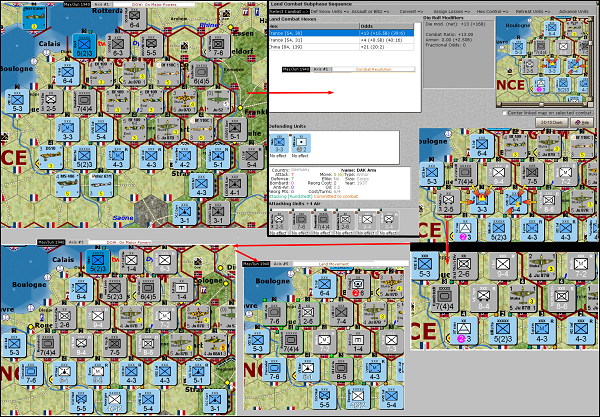
In the upper left screenshot you can see the German advance after combat from the attack at the end of the previous turn. That turn ended after the Axis impulse on a die roll of 3 (groan from G). Then the Axis won the Initiative (anguished cry from G) and I elected to move first (duh!). This is the deadly “end the turn” and “start the next turn” combination that no World in Flames player has ever found a defense against. G’s comment: 3 excellent die rolls in a row!
At this point I had Italy DOW France (not the Commonwealth). That let the 3 bombers in northwestern Italy (refer back to Figure 1-1) fly ground strikes against the French units in and around Paris. Due to surprise, neither the French nor the British could interfere with those ground strike missions and the effectiveness of each bomber was doubled. Each of those attacks had a poor chance of success, but there were a lot of them. Many failed, but not all.
Given that it is May/June, the Fine weather in the North Temperate weather zone was to be expected. The upper right screenshot, with magnified insert, shows the two German attacks in May/June impulse #1, which are quite nice. Both the +15 DRM and the +8 DRM on the Blitz table succeeded. There was no advance two hexes because G has a solid secondary line. In the lower right corner is the position after the advance after combat and rebasing a German Stuka to the front line.
The screenshot in the lower left shows the position after the French adjusted their front line. I had been careful to not leave German units vulnerable to quasi-good attacks by the Allies. That was somewhat challenging to do because of the fairly long front line. By choosing to attack through the clear terrain hexes between Lille and the Ardennes forest hex, maneuvering units next to Paris became awkward. Enemy zones of control into adjacent hexes prevented freedom of movement, so German unit placement devolved into which units could reach which hexes. The main objective though was to get control of a third hex adjacent to Paris by making that attack as good as possible. At this time, no other attacks seemed necessary for preparing to take Paris. All other German units were positioned to achieve two goals: (1) to make the final attack on Paris next Axis impulse, and (2) to defend.
The bottom center shows the result of the attack on the hex due east of Paris. This gave Germany 3 hexes on Paris. It is now impulse #5 and Germany has repositioned its units to maximize the attack factors on Paris. I also chose to expend an Offensive chit on Rundstedt to make taking Paris guaranteed (+21 DRM). The O-chit doubled the offensive combat strength of 8 German land units. Other players might have decided to save the O-chit for attacking Russia in 1941, since even without it the Paris attack would have been pretty good. But I had troubles in Yugoslavia and Greece that needed help from the German units in France and the Lowlands. By finishing off France in May/June, those units would have all of July/Aug to wend their way east and clean up the mess in the Balkans. Taking all the French units off the map really simplifies things for the Axis. I didn’t want to risk a few bad die rolls messing up the German timetable.
Paris Taken
The last screenshot in this post (Figure 1-3) shows the position after Paris was taken. The French don’t really have any feasible suicide attacks. If they attempt some and fail, the Germans may have a chance to capture more French resources and rail lines to get them back to German factories. The turn continued for several more impulses, but nothing of significance changed in France.
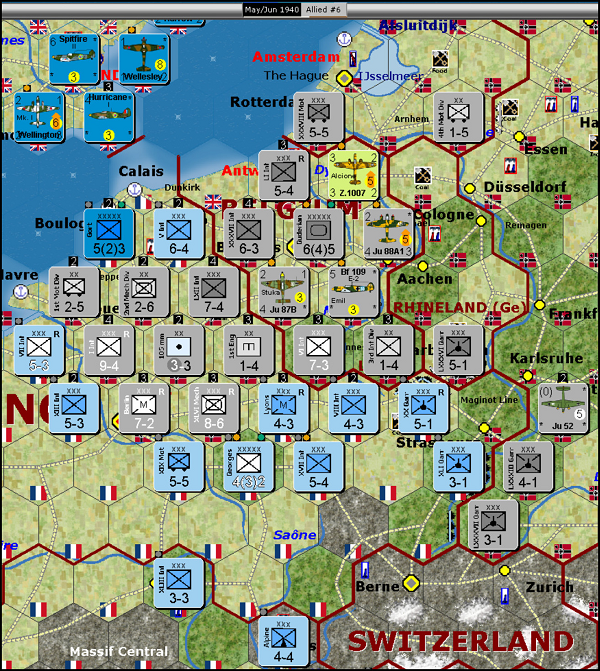
Conclusion
What happened here? The Germans had an excellent position in Belgium at the start of Mar/Apr 1940. Even though the Allies won the initiative and moved first in that turn, and the first 3 weather rolls were poor, Germany was ready to attack once the weather turned fine. Although it was only the 4th turn of the game, Germany had enough armor/mechanized corps and divisions to optimize a Blitz attack, albeit only against 1 hex. Reinforcements in the May/June turn were 2 more mechanized corps, an armor HQ, 2 Stukas, and a good fighter/bomber. All 6 of those units were crucial to the 4 successful attacks in the turn leading to the capture of Paris. Prudently, no unnecessary attacks were made by the Axis. By the end of the turn, the Axis losses were negligible - unless you count the expenditure of the O-chit.
In the second post in this AAR, I’ll go back to earlier turns to show how Germany was able to achieve its lovely position shown in Figure 1-1 of this post. Spoiler alert, the luck of the die rolls ranged from awful to delightful for the Axis - or delightful to awful from G’s perspective.
< Message edited by Daniele -- 4/10/2019 7:51:00 AM >
|
 Printable Version
Printable Version








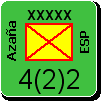
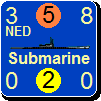


 New Messages
New Messages No New Messages
No New Messages Hot Topic w/ New Messages
Hot Topic w/ New Messages Hot Topic w/o New Messages
Hot Topic w/o New Messages Locked w/ New Messages
Locked w/ New Messages Locked w/o New Messages
Locked w/o New Messages Post New Thread
Post New Thread